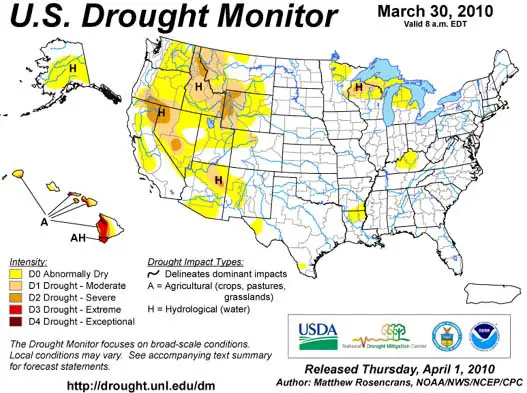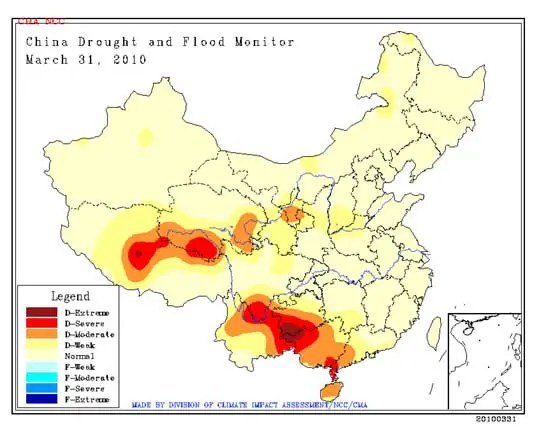Extreme Droughts
According to the U.S. Drought Monitor (USDM), nearly eight percent of theUnited States (including Alaska, Hawaii, and Puerto Rico) was experiencing moderate to severe drought as of March 30th 2010. Drought afflicted 57 percent of Hawaii’s land cover, with part of the northern portion of the Big Island moving into exceptional drought at the beginning of the month for the first time since the inception of the USDM in 1999. Exceptional drought is extreme drought and is the most serious category as defined by the USDM. According to NOAA’s Climate Prediction Center, the El Niño phenomenon—anomalously warm ocean waters in the equatorial Pacific—is responsible for the continuing dry conditions over Hawaii.

At the end of March 2010 in China, moderate to severe drought persisted in the provinces of Yunnan, Guizhou, southern Sichuan, and northwestern Guangxi in South China. Since fall 2009, drought conditions have affected more than 60 million people and ruined billions of dollars worth of crops in southwest China. According to a director at the Yunnan Land Resources Bureau, this is the worst drought in a century for parts of this province.

In Australia the Bureau of Meteorology reports that, “For the 8-year period from April 2002 to March 2010 (96 months), much of southeastern Australia is covered by severe rainfall deficiencies. Around 95% of Victoria has received rainfall in the lowest 10% of historical totals when considered over such a time period. The southeastern corner of Queensland is also covered by serious to severe rainfall deficiencies when considered over this time period; recent rains have not been enough to remove deficiencies. Serious to severe deficiencies also remain in central to eastern coastal districts of SA, large areas of Tasmania, especially in the north, and in a large area covering the southwest coast and adjacent inland regions of WA.”
The 13-year period from April 1997 to March 2010 (156 months) shows rainfall deficiencies covering much of the same area, but less of the central parts of the MDB. Most notable are the large areas of lowest on record for this period: large parts of the WA southwestern coast, western Tasmania, and large areas in Victoria received lowest on record rainfall for the 13-year period.
“Whilst recent rains in eastern Australia have provided, in many cases, short-term relief, sustained periods of above-average rainfall are needed to remove these very long-term deficiencies. These long-term deficiencies have taken place against a background of well above average temperatures including Australia’s warmest decade on record.”
Below is a chronology of extreme droughts recorded in Australia;
1864-66 All States affected except Tasmania.
1880-86 Southern and eastern States affected by extreme droughts.
1895-1903 Sheep numbers halved and more than 40 per cent loss of cattle. Most devastating in terms of stock losses.
1911-16 Loss of 19 million sheep and 2 million cattle to extreme drought.
1918-20 Only parts of Western Australia free. 1939-45 Loss of nearly 30 million sheep between 1942 and 1945.1963-68 Widespread and longest drought in arid central Australia:
1958-67. The last two years saw a 40 per cent drop in wheat harvest, a loss of 20 million sheep, and a decrease in farm income of $300-500 million.
1972-73 Mainly in eastern Australia.
1982-83 Total loss estimated in excess of $3000 million. Most intense drought in terms of vast areas affected.
1991-95 Average production by rural industries fell about 10 per cent, resulting in possible $5 billion cost to the Australian economy, $590 million drought relief provided by the Commonwealth Government between September 1992 and December 1995.
2002-08 The extreme drought in Australia is the worst in 100 hundred years. The Australian government announced more than A$1 billion in drought aid in 2009, taking government drought support to more than A$3 billion since 2001.
